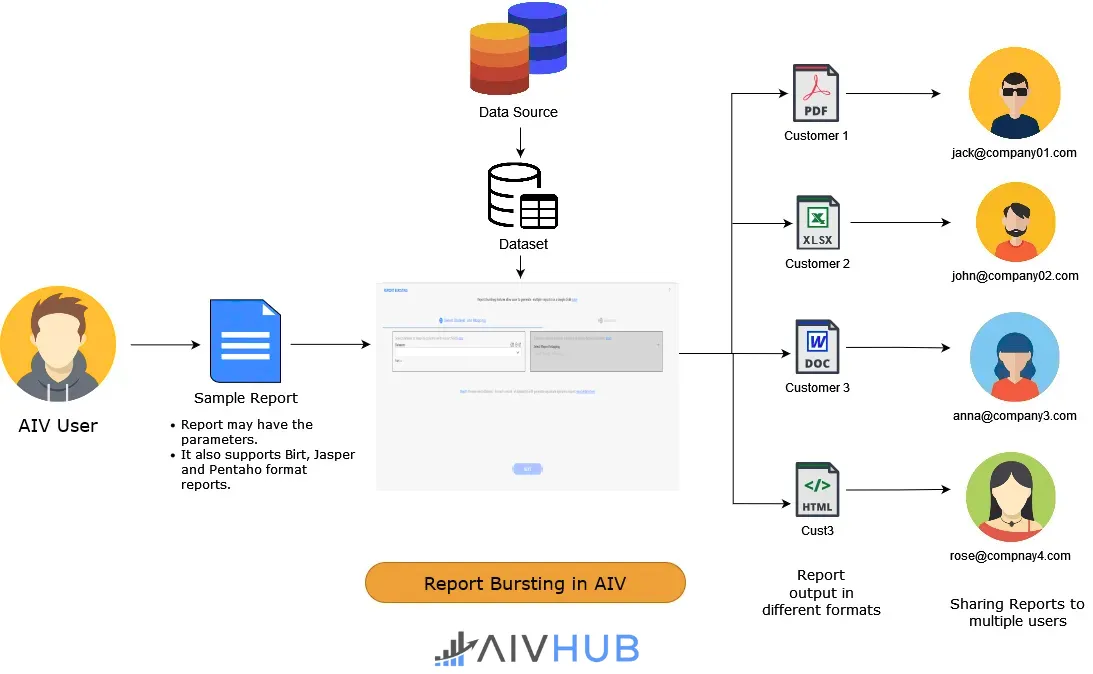Introduction
Report Bursting is a feature used when the same report needs to be created and delivered to multiple users, each possibly requiring:
- A different output format, and/or
- User-specific data within the report.
This process enables users to distribute reports to various recipients in a single operation, eliminating the need to manually generate the same report multiple times.
Core Capabilities
Report Bursting offers powerful features that significantly enhance productivity and save valuable time compared to traditional manual reporting processes. Key advantages include:
- Efficient Mass Distribution: Generate and share the same report with unlimited users simultaneously through automated email delivery, eliminating the need for repetitive manual sending.
- Personalized Data for Each User: Create reports containing user-specific information, ensuring each recipient receives only the data relevant to them while maintaining data privacy and confidentiality.
- Multiple Format Support: Produce reports in various formats including PDF, XLSX, Word, and HTML based on user preferences and requirements, providing flexibility in how information is consumed.
- Customized Report Naming: Personalize and distribute the same report template with different user names, improving organization and making it easier for recipients to identify their specific reports.
- One-Click Automation: Execute complex distribution workflows with a single action, transforming hours of manual work into seconds and freeing managers to focus on strategic activities rather than administrative tasks.
Report Bursting: This video explains about report bursting in the application.
Skill Level Required
Users should have a basic knowledge of report scheduling in AIV.
Practical Example
Please refer to the diagram below for a high-level understanding of Report Bursting.

In this example, a single report is shared with multiple users, each receiving data relevant to them in their preferred output format. The recipients may or may not belong to the same organization. The diagram illustrates four users — Jack, John, Anna, and Rose — each associated with different organizations: Company1, Company2, Company3, and Company4, respectively.
| User | Organization | Required Format | Use Case |
|---|---|---|---|
| Jack | Company1 | Distributing finalized, non-editable reports to stakeholders | |
| John | Company2 | XLSX | Performing detailed data analysis and calculations |
| Anna | Company3 | Word (DOCX) | Adding commentary and supplementary information |
| Rose | Company4 | HTML | Integrating content into web-based applications |
Report Bursting generates all four versions with personalized data and delivers them via email, automatically and simultaneously. All you need is to bring all the required data into the dataset and provide it to report bursting.
Let’s understand this with one business requirement:
Problem Statement
There is a company XYZ where Sam is the Sales Manager. Sam has many salespersons working under him and needs to share Target vs. Achieved sales data with each salesperson at the end of each month. Currently, Sam generates these reports employee-wise manually, which is very monotonous and time-consuming, especially at the month-end. This is a common problem faced in many organizations where managers must create and distribute individualized performance reports to multiple team members on a regular basis.
Solution
Report Bursting is a solution to this monotonous and time-consuming task of generating and sharing reports with employees. Using report bursting, Sam can generate and send numerous reports with a single click. This saves a lot of time, and importantly, it is a one-time setup. Once Report Bursting is created, Sam can schedule the report generation and sharing process every month, automating the entire workflow. This automated approach eliminates manual effort, reduces errors, and allows Sam to focus on more strategic activities while ensuring each salesperson receives their personalized performance data on time.
The following three scenarios illustrate the advantages of report bursting.
Scenario
1. Generate and Share a Single Report with Multiple Users
This scenario demonstrates how to distribute the same Top 5 Customers Report to multiple users at once using the Customers dataset, which contains user names and email IDs. Instead of manually sharing the report with a large number of employees, Report Bursting enables bulk distribution in a single execution and can be automated through scheduling.
For step-by-step instructions on how to share the same report with multiple users, click here.
2. Generate and Share Reports in Different Output Formats
This scenario demonstrates how to distribute the same report to multiple users, where each user receives the report in a different output format as defined in the dataset. The Customers dataset includes user names, preferred output formats, output paths, and email IDs. Using Report Bursting, the report is generated and shared with all users in a single execution, ensuring each user receives the format they need.

For step-by-step instructions for this scenario, click here.
3. Generate User-Specific Reports
This scenario demonstrates how to generate and share reports that contain data specific to each user. The Order Details Report requires an order number as a parameter, and the Order Details dataset provides the order numbers along with user information. Using Report Bursting, the report is executed for each order number in the dataset, ensuring every user receives only their own report output.
For step-by-step instructions for this scenario, click here.